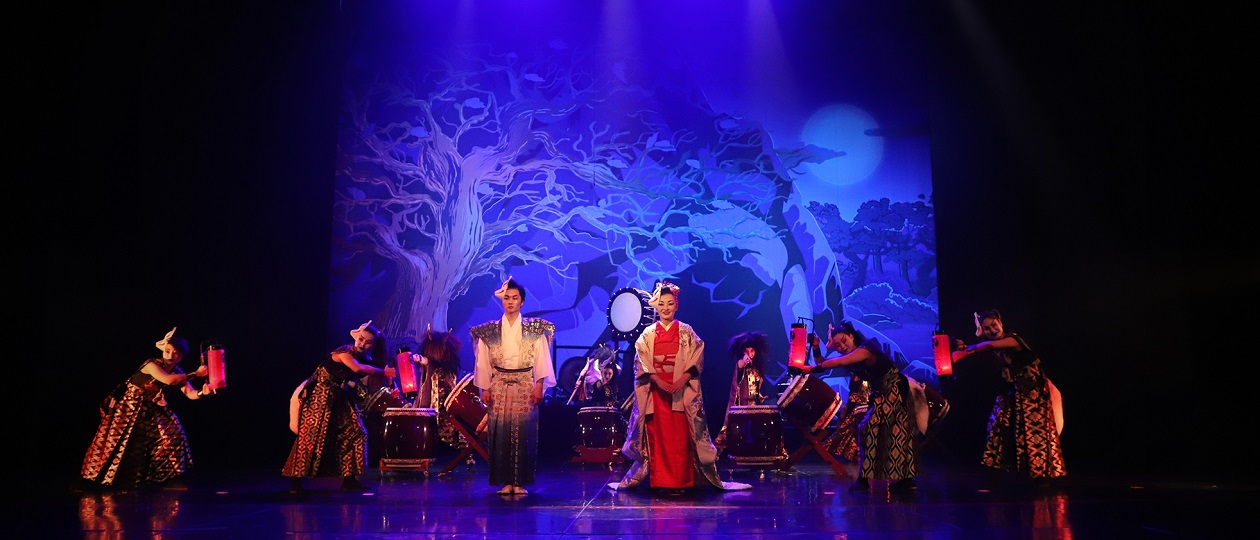
The invitation of friends to the drum show “The Sea of the Blue Forest” at the Teatrium was a complete surprise for me, but I immediately accepted it, because I really wanted to compare the Russian version of the performance with the performance I saw at Caesars Palace in Las Vegas back in 1993.

And looking ahead a little, I must admit with some surprise that I was not disappointed with the Moscow troupe of drummers.
Yes, of course, the impression of the scale of space and scenery of Cirque Du Soleil at the premiere of the Mystère show with the scene of impeccable performance of taiko by artists of one of the most recognized modern circuses in the world was so fixed in my memory then that it became for a long time my personal reference idea of this art from Japan.
However, the Montreal circus paid all attention exclusively to the percussion technique and completely neglected the ethnic peculiarity of Japanese art. Later, after watching the performances of Japanese artists, I reconsidered my attitude towards the reference taiko. And it was important for me to see how this was solved in the production of young Russian artists, and the program of the show in Japanese style inspired me with hope, where the Japanese taiko master Takuya Taniguchi was listed as a mentor, composer and arranger.

Of course, this is not a spoiler, and I will not retell the plot of the show, but the main thing is that it really exists and is dedicated to the classic Japanese theme of the relationship between humans and youkai with a romantic touch inherent in the image of the nine-tailed werefox Kitsune (狐, Kitsune).

Of course, one can find fault with the plasticity of the movements of young actresses, who have too big a step, which is not typical for Japanese women, and still have an uneven command of the language of poses, which is so important for Japanese stage choreography. But I was very pleased with the natural cheerful energy with which each scene of the show played out.
The sincerity and diligence of the musical and choreographic performance of each act emotionally captivated the audience, who were instantly drawn into the performance and enjoyed the lively rhythms of taiko. And this powerful rhythmic action itself was delightfully complemented by the subtle playing of musicians on traditional instruments koto (箏, koto) and shakuhachi (尺八, shakuhachi).

In this naturalness and in combinations of rhythm and choreography, the authenticity of the creation and the birth of the original work were felt, and therefore the hall held its breath, and the hearts of the audience seemed to beat in the same rhythm with the hearts of the performing artists.
I have no doubt that all those present that evening in the hall and, of course, on the stage received a powerful positive charge of the holiday and involvement with real art.
And if you decide to experience the mood of traditional Japanese holiday entertainment, I sincerely recommend that you visit a Japanese drumming show or, in other words, a performance by a professional taiko (太鼓, taiko) troupe, by the way, “taiko” literally means “big drum”.
But I wanted to supplement my story about the show with reasons why I fully allow the performance of taiko rhythms not only by Japanese bands. However, taiko rhythms are already developing within the cultures of many nations and have begun to express new forms of creativity and social life.

The history of Japanese taiko drums is very long and began even before our era during the Jōmon period (縄文時代, Jōmon jidai, literally – “the era of the rope ornament”), when the island population was engaged in hunting, fishing and gathering. As a result of field ethnographic research, it turned out that even then big drums were used as a means of transmitting information at a distance, and later and especially during the Sengoku period (戦国時代, Sengoku Jidai, “the era of the warring provinces”), they inspired Japanese warriors to fearless battle and legendary victory.
Taiko acquired a new musical and entertainment mission relatively recently in the post-war years of the 20th century, and thanks to its thunderous sounds with rolling reverberation and impressive synchronicity of group performances, it first conquered the Japanese audience in the 1950s, and already in the 1970s gained wide world fame thanks to tours Japanese drumming groups.
And almost immediately, their unprecedented and powerful stage choreography, coupled with bewitching ethnic mysticism, gave rise to the phenomenon of the emergence of similar local groups, which included not only ethnic Japanese, but also numerous representatives of other nations.
And if at first it seemed only a frank imitation, then the further world popularization of the new musical and choreographic art led to its involvement in global cultural processes.
Today, over 400 professional and amateur groups of taiko drummers perform in the US and Canada alone, and San Diego and several other cities regularly host conferences of musicians, where issues are discussed and agreed upon from the education of youth to the acceptable aesthetics of performances that are increasingly taking place not only on stages. , but also at open mass venues in the form of various performances.
And, frankly, I am very pleased that the percussion art of taiko has gained recognition in Russia, and every year the first domestic team of the Japanese drum show TAIKO inspiration is gaining experience and popularity. Of course, as pioneers of taiko, it is difficult for a young artist, but everything is clear, playing the “big drums” was worth it, and in eight years the group has developed, grown up and firmly taken its place on the Russian stages.
I believe that after a tour of Russia, the first big international tour is just around the corner, and, consequently, the appearance among fans of a group of citizens of many other states. After all, Japanese taiko and their rhythms have already become the cultural heritage of the whole world, and perhaps someday UNESCO will add the Japanese “big drums” to the World Cultural Heritage List.






One comment
Anonymous
21.07.2022 at 13:22
Are all of those articles written you or did you hire a ghost writer?